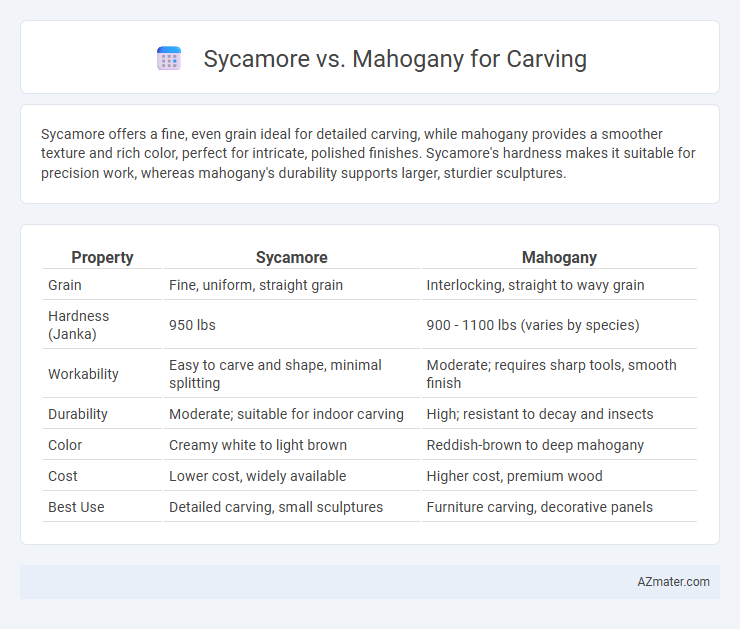Sycamore offers a fine, even grain ideal for detailed carving, while mahogany provides a smoother texture and rich color, perfect for intricate, polished finishes. Sycamore's hardness makes it suitable for precision work, whereas mahogany's durability supports larger, sturdier sculptures.
Table of Comparison
| Property | Sycamore | Mahogany |
|---|---|---|
| Grain | Fine, uniform, straight grain | Interlocking, straight to wavy grain |
| Hardness (Janka) | 950 lbs | 900 - 1100 lbs (varies by species) |
| Workability | Easy to carve and shape, minimal splitting | Moderate; requires sharp tools, smooth finish |
| Durability | Moderate; suitable for indoor carving | High; resistant to decay and insects |
| Color | Creamy white to light brown | Reddish-brown to deep mahogany |
| Cost | Lower cost, widely available | Higher cost, premium wood |
| Best Use | Detailed carving, small sculptures | Furniture carving, decorative panels |
Introduction to Sycamore and Mahogany Wood
Sycamore wood, known for its fine grain and light color, offers excellent workability and smooth finishing, making it a favored choice for detailed carving projects. Mahogany wood, prized for its rich reddish-brown hue and durability, provides a stable and dense material ideal for intricate and long-lasting carvings. Both woods vary significantly in hardness and texture, influencing the final appearance and ease of carving for artisans.
Wood Grain and Texture Comparison
Sycamore wood features a fine, even grain with a smooth texture that allows for detailed and precise carving, making it ideal for intricate designs. Mahogany has a coarser, more open grain with a natural luster, providing depth and warmth in carved pieces but requiring sharper tools to achieve clean edges. The denser texture of mahogany contributes to its durability and strength, while sycamore's lighter, softer texture offers easier shaping and finer surface finishes.
Density and Hardness Differences
Sycamore wood typically has a density of around 450-550 kg/m3 and a Janka hardness of approximately 1,000 lbf, making it relatively soft and easy to carve with fine detail. In contrast, Mahogany is denser and harder, with a density ranging from 500-850 kg/m3 and a Janka hardness between 800-1,220 lbf depending on the species, offering greater durability but requiring more effort during carving. The lower density and hardness of Sycamore allow for smoother cuts and intricate designs, while Mahogany's toughness provides a robust finish suitable for more substantial carvings.
Workability for Carving Projects
Sycamore offers excellent workability for carving projects due to its fine, even grain and moderate hardness, allowing for detailed and precise cuts with minimal effort. Mahogany, while slightly harder, carves smoothly and holds intricate details well, making it preferred for ornate or decorative work. Both woods respond well to hand and machine tools, but sycamore's consistent texture provides an easier experience for beginners.
Detailing and Finish Quality
Sycamore wood offers a fine, uniform texture ideal for intricate carving details, allowing for crisp edges and delicate designs. Mahogany provides a smoother grain that enhances finish quality, resulting in a rich, polished appearance with deep color tones. For high-detail work, sycamore excels, while mahogany is preferred for a luxurious final finish.
Durability and Longevity
Sycamore offers moderate durability with a fine, even grain that resists splitting, making it suitable for detailed carving, but it is less resistant to moisture and decay compared to mahogany. Mahogany boasts superior durability and longevity due to its dense, oily grain, offering excellent resistance to rot and insect damage, which ensures carved pieces endure over time. For carvings requiring extended outdoor exposure or heavy use, mahogany is often preferred, while sycamore fits well for indoor, intricate work with moderate durability needs.
Cost and Availability
Sycamore wood is generally more affordable than mahogany due to its abundant supply in temperate regions, making it a cost-effective choice for carvers. Mahogany, prized for its rich color and fine grain, commands a higher price and is less readily available because of slow growth and restricted harvesting regulations. Availability of mahogany can vary significantly depending on geographic location, whereas sycamore tends to be consistently accessible in many woodworking markets.
Best Uses for Sycamore in Carving
Sycamore wood's fine, even grain and medium hardness make it ideal for detailed carving projects such as figurines, intricate patterns, and utensils where precision is essential. Its light color and smooth texture hold paint and finishes well, enhancing decorative carvings and sculptures. Sycamore also resists splitting, making it a preferred choice for delicate and intricate designs in both functional and artistic carving applications.
Best Uses for Mahogany in Carving
Mahogany is prized in carving for its fine, even grain and natural durability, making it ideal for detailed, intricate work such as furniture embellishments and decorative panels. Its softness allows for smooth cuts and reduces tool wear, especially useful in relief carving and sculptural projects. Mahogany's rich, warm reddish-brown color enhances the aesthetic appeal of carved pieces, often preferred in heirloom-quality and high-end woodcraft.
Choosing the Right Wood for Your Carving Needs
Sycamore offers a fine, uniform grain that carves smoothly, making it ideal for detailed work and delicate designs, while mahogany provides a richer color and excellent durability suited for larger, more robust carvings. Sycamore's lighter weight and ease of finishing suit beginners and intricate projects, whereas mahogany's density and natural oils enhance resistance to wear and create a polished, long-lasting result. Selecting between sycamore and mahogany depends on the desired carving complexity, finish quality, and the wood's ability to withstand handling and environmental factors.

Infographic: Sycamore vs Mahogany for Carving
 azmater.com
azmater.com